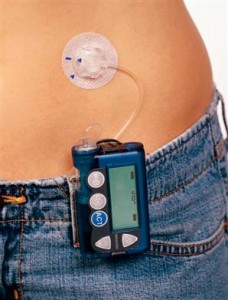 The first use of insulin pumps came in the 1970s when it was used for Type 1 Diabetes. It proved that it could achieve strict glucose control in a selected group of people. Since that time, pumps have become much smaller in size, easier and safer to use, and more durable.
The first use of insulin pumps came in the 1970s when it was used for Type 1 Diabetes. It proved that it could achieve strict glucose control in a selected group of people. Since that time, pumps have become much smaller in size, easier and safer to use, and more durable.
For young children and even infants, an insulin pump may be the best choice for receiving insulin. The use of insulin pumps is continually growing. You never know for sure what a child will do, that includes activities and food intake. Having a pump will help in these everyday unpredictable situations.
Insulin pumps are used to mimic a normally functioning pancreas. As a parent you may be wondering how the pump works. The pump provides a steady line of fast-acting insulin which is called basal insulin. This prevents uncontrolled highs and ketene production. The pump is also used for fast-acting insulin before meals. The dose can be set to the person’s glucose level, the amount of carbohydrates found in the meal, and also by planned activities after the meal.
The pump is about the size of a pager and can easily be carried in your child’s pocket. It works by inserting a small plastic tube under the skin. It is usually put in the areas of the abdomen or buttocks and held with tape. Every three days the tube is changed and a new one is placed in a different area of the body.
There are many advantages for children using insulin pumps. When using a pump, there is less fluctuation between blood glucose which lessens the risk of hypoglycemia. Another advantage is the child only needs one injection site every three days. Having a pump gives the child more freedom to sleep, eat, and do other activities when he or she pleases. One of the best advantages is that using the pump will improve the control of blood glucose which helps avoid the risk of complications in the future.
With all the positives of insulin pumps, there are some disadvantages. Insulin pumps are quite expensive. Not everyone’s health insurance will cover the cost. Another problem with the pump is that some children find the needle more painful than regular insulin needles because the pump needle is larger. Because the pump has to be carried around, some children do not like it because it reminds them of their disease and makes them feel not like their peers.
Many families are used to giving their children multiple injections per day. When choosing the pump, the family will have to learn how to manage the Diabetes differently. Before choosing the pump for your child, do research about it. If your child is old enough, talk to them and see how they would feel about switching to the pump. Also make sure your child’s Diabetes team has experience so they can help through the transition.
Choosing the insulin pump can really change your child’s life. It will give them more independence and freedom to do everyday things. The insulin pump can help your child not have to focus on their disease as much and be a normal kid.